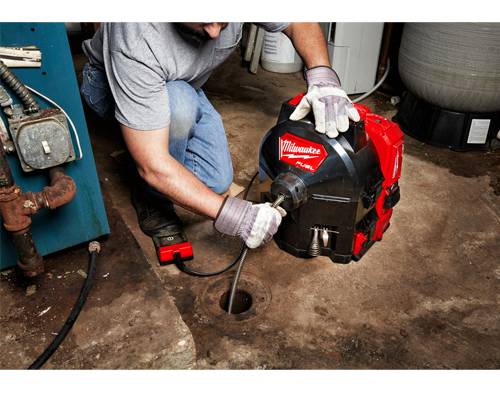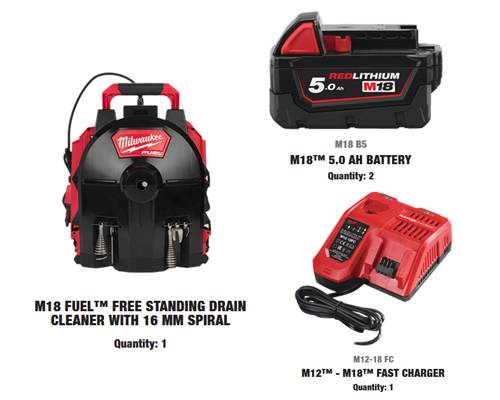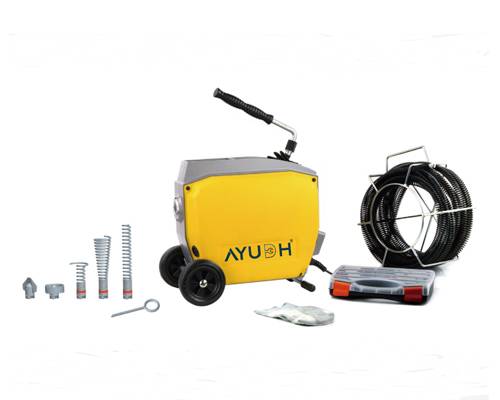Understanding Cordless Drain Cleaning Machines
Cordless drain cleaning machines have emerged as a revolutionary tool in plumbing.
When selecting a cordless drain cleaning machine, consider factors such as:
- The size and type of drains you’ll be working on.
- Battery life and power to match your specific needs.
- Additional features like adjustable settings and accessories.
In conclusion, cordless drain cleaning machines are valuable tools for maintaining your plumbing and tackling clogs effectively. Their portability, efficiency, and environmental benefits make them a worthy investment for any homeowner. Whether it’s a minor blockage or a more stubborn clog, these machines can save you time, money, and the hassle of dealing with plumbing issues.

Why Choose Cordless Drain Cleaning Machines
Cordless drain cleaning machines offer unparalleled convenience and efficiency in tackling stubborn clogs. Their battery-powered operation allows for hassle-free maneuverability, making them a superior choice over manual tools.
How to Choose the Right Cordless Drain Cleaning Machine
- Consider the size and type of drains in your household.
- Evaluate battery life and power for your specific needs.
- Look for additional features like attachments and adjustable settings.
Types of Cordless Drain Cleaning Machines
There are two primary types of cordless drain cleaning machines: drum machines and sectional machines. Each has its own advantages and best-use scenarios.
Drum Machines
- Ideal for smaller, residential pipes.
- Compact and easy to transport.
- Suitable for moderate clogs.
Sectional Machines
- Designed for larger, commercial pipes.
- Provide more power and versatility.
- Recommended for severe clogs and professional use.

How to Use a Cordless Drain Cleaner Effectively
Before diving into the specifics of usage, it is imperative to choose a cordless drain cleaner that suits your needs. Consider factors such as the type of drains you’ll be working on, the power of the machine, and the attachments it comes with. A versatile cleaner with various attachments is ideal for handling different types of clogs.
Safety First
Before using any power tool, safety should be the top priority. Equip yourself with protective gear, including gloves and safety goggles, to shield against any potential splashes or debris. Additionally, ensure the area is well-ventilated to prevent inhaling any fumes.
Preparation
Inspect the Drain
Begin by visually inspecting the drain. Remove any visible debris or hair near the surface. This initial step helps prevent the cleaner from getting stuck on larger obstructions.

Set Up the Machine
Assemble the cordless drain cleaner according to the manufacturer‘s instructions. Ensure the batteries are fully charged for optimal performance.
Executing the Cleaning Process
Inserting the Cleaner
Gently insert the drain cleaner into the pipe. Apply steady and even pressure, avoiding excessive force that could cause damage.
Rotational Motion
Turn on the machine and let it work its magic. The rotational motion of the cleaner’s auger or blades will effectively break down the clog.
Controlled Movement
Move the cleaner in a controlled manner, allowing it to navigate through the curves and bends of the pipe. Avoid abrupt movements that might cause the cleaner to get stuck.
Handling Stubborn Clogs
For particularly tough clogs, consider using specialized attachments or adjusting the settings on your cordless drain cleaner. Patience is key; allow the cleaner to work through the obstruction gradually.

Post-Cleaning Steps
Flushing the Drain
After successfully clearing the clog, run hot water down the drain to flush out any remaining debris. This final step ensures a thorough clean.
Cleaning and Maintenance
Properly clean and sanitize your cordless drain cleaner after use. This ensures it’s ready for the next job and extends its lifespan.
By following these steps, you can effectively use a cordless drain cleaner to tackle even the most stubborn clogs. Remember, safety and preparation are crucial. With the right technique and the appropriate cleaner, you’ll be able to keep your drains flowing smoothly.
Comparing Cordless and Manual Drain Cleaning
The Traditional Approach: Manual Drain Cleaning
1.1 Tools Used in Manual Drain Cleaning
Manual drain cleaning typically involves tools like plungers, drain snakes, and plumbing augers. These tools rely on physical force and maneuvering to dislodge clogs.
1.2 How Manual Drain Cleaning Works
A plunger creates pressure that dislodges minor obstructions, while drain snakes and augers physically break down and remove clogs.
1.3 Effectiveness and Limitations
Manual methods are effective for small to moderate clogs but may struggle with severe or deep blockages. They also require physical exertion and can be time-consuming.

The Modern Solution: Cordless Drain Cleaning Machines
2.1 How Cordless Drain Cleaning Machines Operate
Cordless machines use battery-powered motors to rotate specialized attachments, effectively breaking down and removing clogs from pipes.
2.2 Advantages Over Manual Methods
Cordless machines offer greater power, efficiency, and versatility. They can tackle more stubborn clogs and are less physically demanding to use.
2.3 Considerations Before Using Cordless Machines
Users should be aware of battery life, attachment compatibility, and safety precautions when operating cordless drain cleaning machines.
3.1 Efficiency and Speed of Operation
Cordless machines tend to clear clogs faster and with less effort compared to manual methods, making them a more efficient choice.
3.2 Safety Considerations
While both methods have safety considerations, cordless machines may pose fewer risks of physical strain or mishandling.
3.3 Environmental Impact
Manual methods are generally more eco-friendly, as they don’t rely on batteries or electricity. Cordless machines have a higher environmental footprint.
3.4 Cost-effectiveness
While cordless machines may have a higher initial investment, they can save money in the long run by reducing the need for professional plumbing services.

Choosing the Right Method for Your Needs
4.1 Factors to Consider
Consider factors like the severity of the clog, the type of pipes in your home, and your comfort level with the chosen method.
4.2 Scenarios Favoring Manual Cleaning
Manual cleaning may be preferable for minor clogs or in situations where power tools are not readily available.
4.3 Scenarios Favoring Cordless Machines
Cordless machines excel in situations where clogs are severe, deep-seated, or occur frequently.
Methods to use drain cleaning machine
5.1 Can I use a cordless drain cleaner on all types of pipes?
Cordless drain cleaners are versatile and can be used on various pipe materials, including PVC, metal, and more.
5.2 Are manual drain cleaning tools easy to use for beginners?
Yes, manual tools like plungers are user-friendly and a good starting point for those new to drain cleaning.
5.3 How often should I clean my drains to prevent clogs?
Regular maintenance every few months is recommended to prevent major clogs from forming.
5.4 Are there any safety precautions I should take when using drain cleaning tools?
Always wear protective gear, such as gloves and safety goggles, and follow the manufacturer’s guidelines for safe use.
5.5 Which method is more cost-effective in the long run?
While cordless machines may have a higher upfront cost, they can save money over time by reducing the need for professional plumbing services.

Safety Considerations When Using Drain Cleaning Machines
Understanding the Basics of Drain Cleaning Machines
1.1 Types of Drain Cleaning Machines
There are various types of drain cleaning machines available, including handheld augers, drum machines, and powerful sectional machines. Each type comes with its own set of safety considerations.
1.2 How Drain Cleaning Machines Work
Most drain cleaning machines operate by rotating a cable or auger, effectively breaking down clogs and obstructions. Understanding this mechanism is crucial for safe operation.
Importance of Safety Measures
2.1 Potential Hazards
Using drain cleaning machines improperly can lead to accidents, including electrical shocks, chemical exposure, and physical injuries from machine components.
2.2 Precautionary Measures
Always read and follow the manufacturer’s instructions. Use appropriate safety gear, ensure proper ventilation, and be aware of potential hazards in the surrounding area.
Necessary Safety Gear
3.1 Protective Clothing
Wear gloves, safety goggles, and long-sleeved clothing to protect against potential splashes or contact with chemicals.
3.2 Essential Safety Equipment
Keep a first aid kit, fire extinguisher, and emergency contact information readily available in case of accidents or emergencies.

Setting Up a Safe Workspace
4.1 Clearing the Area
Remove any obstacles or clutter around the drain area to create a safe workspace with ample maneuvering space.
4.2 Adequate Lighting
Ensure that the area is well-lit to avoid any accidents or mishandling of the machine due to poor visibility.
Continue the article with similar detailed explanations for each subheading. Provide practical tips, expert advice, and actionable steps for the reader to follow. Keep the language engaging and informative, ensuring the content remains valuable throughout.
In conclusion, investing in a cordless drain cleaning machine can transform how you approach household plumbing maintenance. While prices vary based on features and brands, it’s crucial to strike a balance between affordability and functionality. Remember to consider your specific needs and the long-term savings potential.